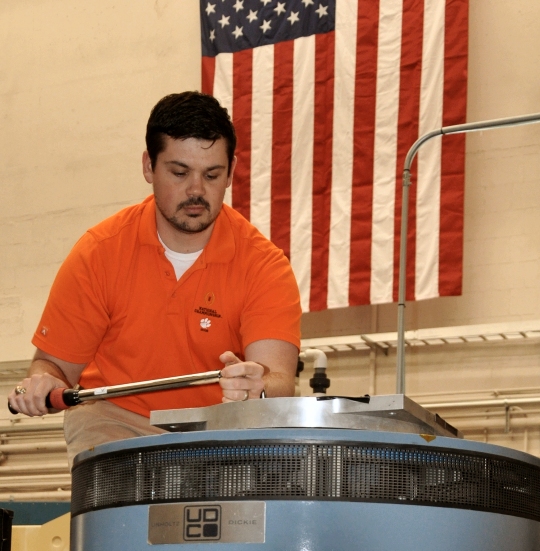 DAHLGREN, Va. - Naval Surface Warfare Center Dahlgren Division (NSWCDD) engineer Shawn Schneider mounts an adapter plate to an Unholtz-Dickie T-2000 electro-dynamic vibration system capable of providing over 24,000 pounds of force in vibration at frequencies up to and exceeding 3,000 hertz (cycles per second). These systems are used to replicate shock and vibration environments experienced by test items during their lifecycle to ensure that performance and safety are not compromised prior to use by the warfighter. NSWCDD announced on March 20 that Schneider won the 2018 Department of the Navy Award for Technical Excellence at a Test and Evaluation Facility or Range. The engineer was honored for extraordinary scientific and engineering contributions to the test and evaluation community in the area of multi-input-multi-output vibration test profiles. (U.S. Navy photo by John Joyce/Released)
DAHLGREN, Va. - Naval Surface Warfare Center Dahlgren Division (NSWCDD) engineer Shawn Schneider mounts an adapter plate to an Unholtz-Dickie T-2000 electro-dynamic vibration system capable of providing over 24,000 pounds of force in vibration at frequencies up to and exceeding 3,000 hertz (cycles per second). These systems are used to replicate shock and vibration environments experienced by test items during their lifecycle to ensure that performance and safety are not compromised prior to use by the warfighter. NSWCDD announced on March 20 that Schneider won the 2018 Department of the Navy Award for Technical Excellence at a Test and Evaluation Facility or Range. The engineer was honored for extraordinary scientific and engineering contributions to the test and evaluation community in the area of multi-input-multi-output vibration test profiles. (U.S. Navy photo by John Joyce/Released)DAHLGREN, Va. (March 20, 2018)—Shawn Schneider won the 2018 Department of the Navy Award for Technical Excellence at a Test and Evaluation Facility or Range, Naval Surface Warfare Center Dahlgren Division (NSWCDD) announced March 20.
The Navy engineer was honored for his extraordinary scientific and engineering contributions to the test and evaluation community in the area of multi-input-multi-output (MIMO) vibration test profiles.
"I am very excited and honored to bring this award to Dahlgren," said Schneider, NSWCDD Vibration Testing Group lead, after learning about the award, presented by the Navy Chief of Naval Operations. "MIMO vibration is the future of our industry and it is very exciting to be on the cutting edge of this technology."
In addition to his technical achievements, Schneider was honored for his sustained leadership and steadfast direction that have been, and continue to be instrumental in transforming DoD standards for executing vibration testing in compliance with strict military specifications.
"Promoting the state-of-the-art has taken a team effort and I want to personally thank my research partner, Dr. Luke Martin, IAR (Independent Applied Research) Program Director Dr. Jeff Solka, the Missile Defense Agency, and our Test and Evaluation Division management for funding and empowering us to reshape the way we conduct vibration tests," said Schneider.
ILIR (In-House Laboratory Independent Research) and IAR programs help the Dahlgren workforce to actively participate in the creation of future naval innovations. "Such innovations often determine success or failure in naval conflicts that may occur 10 to 20 years in the future," said Solka.
The MIMO vibration team effort spearheaded by Schneider and Martin has revolutionized the Navy's vibration test research, paving the way to make multiple-degree-of-freedom vibration the norm in the Department of Defense.
"His contributions ensure more realistic safety testing across an item's entire life cycle, ultimately resulting in more cost efficient test and evaluation and an increase in weapon safety," according to the nomination. "Mr. Schneider's vast knowledge, expertise, vision, and innovative approach have proven invaluable to NSWCDD, the Warfare Center community, and the Navy."
The selection process for the Navy Test and Evaluation Award winners was highly competitive with outstanding nominations submitted from the Naval Systems Commands and Navy and Marine Corps Operational Test Agencies, said Rear Adm. David Hahn, Innovation, Technology Requirements and Test and Evaluation director for the Office of the Chief of Naval Operations, in his announcement.
In all, there were nine award winners in seven categories. Another Naval Sea Systems Command employee—Brandon Brown from the Program Executive Office Littoral Combat Ship Mine Warfare Program Office (PMS 495)—was awarded the Department of the Navy Lead Tester Award for superior performance of his duties while assigned as Principle Assistant Program Manager for Test and Evaluation.
NSWCDD, a Naval Sea Systems Command warfare center division, is a premier research and development center that serves as a specialty site for weapon system integration. The command's unique ability to rapidly introduce new technology into complex warfighting systems is based on its longstanding competencies in science and technology, research and development, and test and evaluation.


